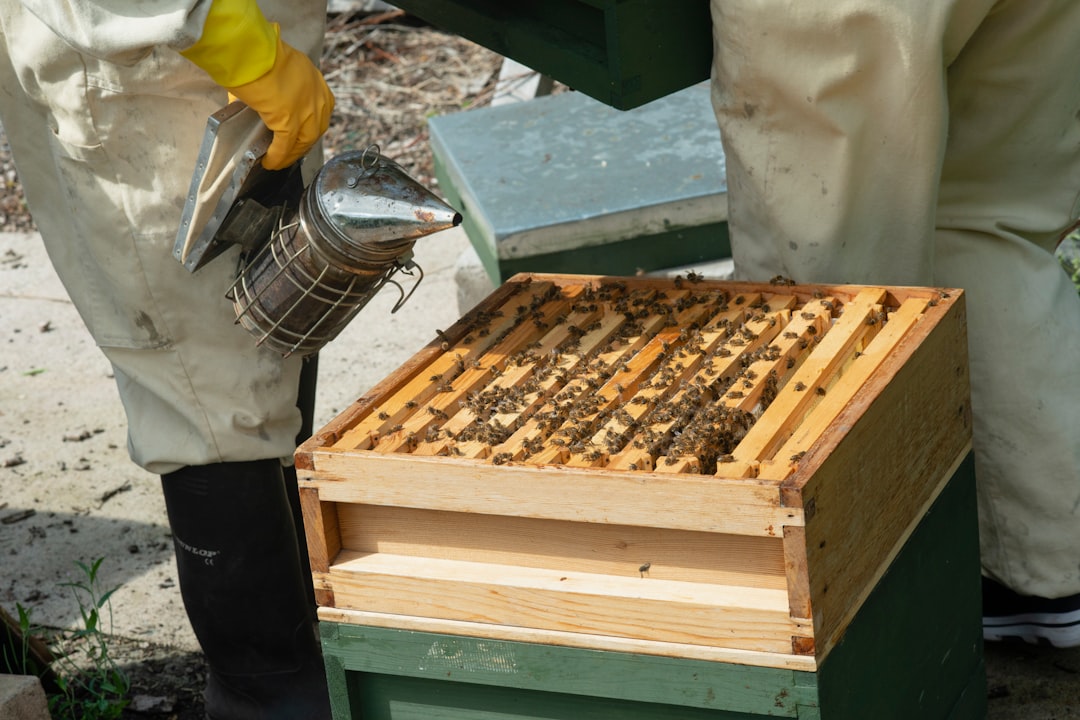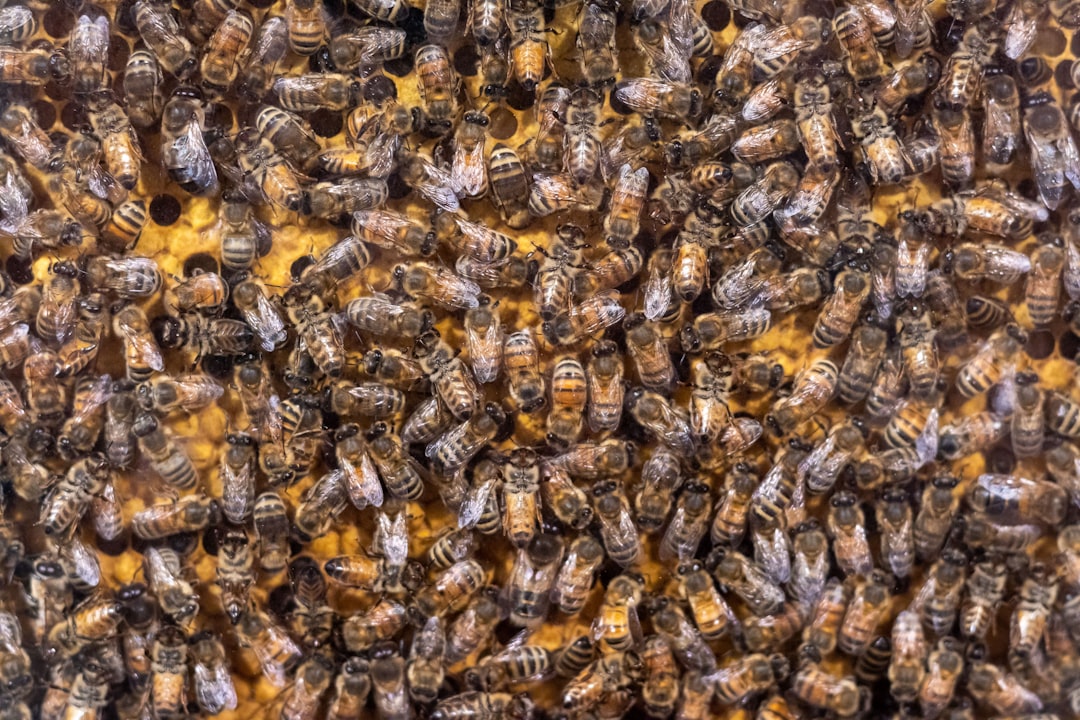

Engage prospects with a scan and streamline customer engagement with FREE QR code marketing tools by Sona – no strings attached!
Create a Free QR CodeFree consultation

No commitment

Engage prospects with a scan and streamline customer engagement with FREE QR code marketing tools by Sona – no strings attached!
Create a Free QR CodeFree consultation

No commitment
Bee extermination services have become a critical necessity for homeowners and businesses facing the risks and challenges of bee infestations. As urban and suburban areas continue to expand, bee colonies increasingly infiltrate residential and commercial properties, creating safety concerns and operational disruptions. Many providers struggle with missed high-value prospects when outreach relies on traditional methods like printed flyers or static signage because these approaches are hard to track and do not capture the intent or urgency of potential leads in real time.
Despite widespread recognition of bee infestations as urgent issues, service providers still feel the pain of poor visibility into who exactly is responding to their marketing. It is not uncommon for quality prospects to walk away untracked simply because their traffic is not captured or integrated into any CRM system. QR codes offer a modern, streamlined avenue for bee extermination services to bridge these gaps, connecting property owners at the moment of need and enabling on-the-spot lead capture, estimate requests, or direct access to vital information. Using QR codes turns every physical asset, from business cards and magnets to door hangers, into a live portal for client engagement, no longer leaving potential leads to slip through the cracks. Add QR codes to leave-behind stickers and labels to keep response paths handy.
This guide explores the practical steps and legitimate advantages of implementing QR code campaigns for real pest control scenarios. From lead qualification to response tracking and customer education, you will discover how QR codes can help bee extermination professionals move beyond outdated, manual workflows and into data-driven, dynamic strategies that increase visibility, improve client experience, and drive measurable results across every stage of the sales journey.

Many bee extermination providers still rely on outdated tactics like door-to-door flyers and manually logged inquiries, practices that often result in missed or incomplete lead data. When a homeowner sees a flyer but cannot easily respond, or when a property manager jots down a contact only to misplace it later, high-value prospects go untracked and outreach opportunities vanish. QR codes bridge the gap between physical presence and digital interaction, increasing both accessibility and lead capture with a simple scan that requires no app download.
To make QR codes work in the field, focus on a few high-impact use cases that replace friction-heavy workflows. Instead of asking someone to call a general line, direct them to a prefilled form in seconds, such as a Google Forms QR. Rather than handing out static brochures that are easily lost or outdated, send people to living resources that can change as your services evolve. The result is a faster, more reliable path from discovery to action and a cleaner data trail inside your CRM.
With the right setup, QR codes become an always-on access layer for your business. They connect the field to your digital systems, turning paper touchpoints into measurable, revenue-generating assets that speed service and improve client confidence.

In bee extermination, the window of opportunity to connect with a client is often narrow. Prospects living with an active infestation seek immediate solutions, yet disconnects between offline promotions and online response options often cause leads to vanish before they are ever registered. If teams cannot see which property owners interacted with their ads or which areas exhibit the most urgency, budget gets wasted on unqualified or cold traffic and response times suffer when they should accelerate. As a testament to their flexibility, QR-coded bees have even been used in research to track behavior at scale.
QR codes remove this friction. They create instant, trackable connections from every flyer, vehicle, magnet, and door hanger to a digital destination that captures intent in real time. A property manager who scans a lobby sign can submit a prefilled emergency request. A homeowner who scans a mailbox insert can schedule a site inspection. Each action is captured with source, time, and location, giving you a documented path from scan to booked job.
Beyond speed, QR codes support dynamic content that evolves with the season. In spring, link to swarm education and preventive inspections. In summer, prioritize urgent removal requests and safety guides. In fall, shift to hive detection and structural remediation information. Dynamic codes allow these changes without reprinting, which reduces waste and keeps messaging aligned with current risks and regulations.
Trackability is equally crucial. With a platform like Sona QR, each scan becomes a data point. You can attribute results to a specific sign, code design, neighborhood, or crew. This level of visibility solves inconsistent messaging, enables geo-targeted campaigns, and makes follow-up more relevant. For small and medium-size operations where resource allocation matters, QR-driven access means fewer missed leads, smarter dispatching, and a clear line from marketing investment to revenue.
Selecting the right QR code format is essential because it shapes the action your prospect can take and the data you can capture. Bee extermination services commonly use formats that either collect contact details immediately or deliver trust-building information at the exact moment it is needed. Dynamic codes are usually the best choice, since you can update destinations without reprinting and capture analytics that static codes cannot provide.
The most effective approach is to map formats to goals and physical media. For urgent requests, use SMS or form-based destinations that accelerate triage. For education and proof of professionalism, use web links and vCards that anchor trust and make it simple to save contact information. For team operations, Wi-Fi access and app download links can streamline communication on complex job sites.
Advanced QR platforms like Sona QR support all of these formats, with dynamic options that make it easy to adjust landing pages as campaign priorities change. This flexibility helps ensure the destination always matches the season, the risk profile, and your current service offerings.

Growth in bee extermination is won by being present at the moment of need and by measuring which touchpoints consistently spark that moment. Many teams scatter flyers across neighborhoods without clear feedback on what resonates. By placing QR codes where urgency emerges and tying each code to a specific use case, you turn every exposure into a data signal that can be optimized.
Start by mapping physical environments to likely intent. High-traffic placements like service vehicles and property entrances reach broad audiences, while focused placements like mailbox inserts or HOA emails reach decision makers. Each location should carry a call to action matched to the context: urgent removal on front desk signage, education and inspection scheduling on seasonal mailers, and vCard saves on business cards.
By tracking scans by placement, time of day, and neighborhood, you can double down where engagement is strongest and pivot away from underperforming zones. Over time, this creates a virtuous cycle where every printed asset informs the next campaign with evidence instead of guesses.

The most impactful QR code use cases are those that remove time, uncertainty, or friction from a prospect’s decision. In bee extermination, that usually means fast booking for emergencies, streamlined quoting for new jobs, and educational content that reduces fear and increases trust. Each use case should map to a clear action you can measure.
Think about the journey in three stages: awareness, consideration, and conversion. Awareness involves education and brand credibility. Consideration involves proof, estimates, and scheduling. Conversion involves payment, reviews, and referrals. QR codes can enable high-value actions at each stage with scan-to-form, scan-to-call, and scan-to-content experiences.
These scenarios transform static media into automated, measurable interactions. They help teams capture intent at its peak and convert it into scheduled inspections and booked jobs with minimal delay.
Every QR scan carries context: where it happened, what message prompted it, and what action the scanner took next. Without systems to capture and activate this data, promising leads quickly slip away. By assigning unique codes to specific assets and mapping scan intent to lifecycle stages, bee extermination teams can build segmented audiences that fuel more precise retargeting and better follow-through. For activation strategy, see Sona’s retargeting playbook.
Begin by defining your key audience buckets. Homeowners with an active infestation behave differently from property managers planning for seasonal risk. Daytime scans from office parks may represent commercial leads, while weekend scans from residential mailers might signal household decision makers. These distinctions guide messaging and prioritization for sales and dispatch.
A segmented approach increases relevance and speed. It ensures emergency scans trigger immediate callbacks, while education-oriented scans receive helpful content that gently guides them toward inspection or preventive services.
Disconnected campaigns create inconsistent experiences, duplicated outreach, and wasted spend. QR codes function as connectors across offline and online channels, making every physical touchpoint a clear onramp to a digital journey where engagement is recorded and follow-up is automated. For bee extermination services, this means less guesswork and more predictable conversions across print, events, and out-of-home placements. Use multi-touch attribution to understand how each channel contributes.
The key is to align each placement with the most appropriate call to action. A windshield flyer should invite an inspection in two taps. A yard stake after a job should both educate neighbors and offer a quote. A local event banner should deliver a quick swarm guide and a sign-up for a seasonal reminder. Consistency across touchpoints builds brand recall and ensures prospects always know what to do next.
Using a centralized platform like Sona QR ensures all codes are managed in one place, analytics are consistent, and scan activity syncs to your CRM and ad platforms. This creates a connected offline-to-online funnel that preserves context from first scan to final invoice.
Running QR campaigns successfully requires more than printing a code. You need clear objectives, the right code type, thoughtful design, disciplined deployment, and consistent optimization. Treat QR initiatives like scalable programs that evolve as you learn, not one-off experiments that fade after a single drop.
Before you begin, identify which outcomes matter most in your market. For bee extermination services, that usually means reducing response time for urgent calls, increasing inspection bookings from neighborhoods with visible activity, and boosting review volume after successful jobs. Let these priorities guide your use cases and placements.
Define the specific outcome you want: rapid emergency booking, fast estimate collection, seasonal education, or post-service reviews. Match each goal to a placement. For example, lobby signage should prioritize emergency intake while mailbox inserts should lead with inspection scheduling and safety education.
Clarify success metrics before launch. Emergency codes should be judged on average time to callback and booked job rate, while education codes should be measured on content engagement and inspection request conversion. Align internal teams so that scans trigger the right operational response without delay.
Select dynamic QR codes for most campaigns. Dynamic codes provide editing flexibility, scan analytics, and UTM-friendly destinations that support attribution and retargeting. Static codes are suitable only for fixed, evergreen destinations like a general contact page or a PDF that will not change.
Map code format to the action. Use SMS or short forms for emergencies, web links for education and trust pages, vCards for contact saves, and app downloads for customer portals or scheduling tools. With Sona QR, you can manage all of these in one dashboard and update destinations as your campaigns evolve.
Design for scannability and intent. Add a short, benefit-driven call to action like Scan to request immediate bee removal or Scan for a 2-minute estimate. Use high contrast, sufficient white space, and a clear frame. Include your logo inside the code only if testing confirms it does not reduce scan reliability.
Test across real-world conditions. Validate scannability at various distances, angles, and lighting. Check print materials on glossy and matte finishes. Test on common devices and camera apps. A quick pilot across a few placements will surface issues before you scale citywide.
Start with high-impact locations aligned to your growth plan. Prioritize truck signage, yard stakes after jobs, and seasonal mailers targeting known hotspots. Add property manager packets and HOA kits with emergency and education codes. For each placement, capture the unique code ID in your asset tracker so you can attribute scans properly.
Roll out in waves to compare performance. Launch one set of creative in a group of neighborhoods, then test alternate calls to action or landing pages in another group. Monitor scan-to-lead and lead-to-booked rates, then deploy the winner more broadly.
Track scans by time, location, and device, and connect them with downstream conversions in your CRM. Watch for drop-off points in the form experience and shorten fields or add auto-detection where possible. Use A/B testing on landing page headlines, proof elements like reviews, and calls to action. For a deeper framework, compare attribution models to understand which touchpoints drive bookings.
Iterate quickly. If a code on vehicles drives many low-intent scans, revise the CTA to prequalify with language like Scan to book an inspection or to read swarm safety tips. If emergency lobby codes are underperforming, test a larger design and place it at eye level near entrances and elevator banks.

Without robust tracking, bee extermination providers risk misallocating resources and letting high-intent leads slip by unrecorded. Knowing when, where, and by whom a code was scanned informs staffing, territory coverage, creative rotation, and budget allocation. Tracking should not stop at scan counts. It should follow the journey to quote requests, booked jobs, reviews, and referral generation.
A structured analytics approach begins with consistent tagging. Use UTMs and unique code IDs to distinguish assets, calls to action, and neighborhoods. Connect scans to CRM leads with timestamps so that follow-up sequences can be personalized and timed appropriately. Monitor benchmarks like scan-to-form conversion, form completion rate, and booked job rate by placement to identify the highest-return tactics.
Modern QR management platforms make this process straightforward. Sona is an AI-powered marketing platform that turns first-party data into revenue through automated attribution, data activation, and workflow orchestration; with Sona QR and Sona.com, you can:
The result is a closed-loop system that replaces anonymous, untracked behavior with actionable insights. You can identify the placements that produce urgent, qualified work, reduce response delays, and scale the creative and messages that convert best.
QR programs gain compound value when each scan is attributable, each destination is optimized, and each action triggers the next step automatically. The following best practices reflect common media and buyer journeys in bee extermination and are designed to help you improve scan rates, conversion, and ROI.
Train your field teams to promote the codes naturally. A technician who finishes a job can point to the leave-behind magnet and say, Scan this to book your free follow-up inspection or Scan for safety tips about preventing swarms near your patio. When clients understand the benefit in advance, they are far more likely to engage.
Bee extermination is evolving beyond reactive calls and static ads. By embedding QR codes into every point of physical interaction and grounding campaigns in a unified platform, providers can connect with clients in real time, capturing relevant intent signals before competitors do. Start creating QR codes for free, then expand with Sona.com to connect scans to revenue and scale what works.
Enhanced data flow from QR campaigns fuels both marketing and operations, allowing for rapid, personalized responses and smarter use of resources. The result is a digitally enabled service model that delivers peace of mind to property owners and empowers teams with the information they need to drive growth, accuracy, and measurable value in a highly competitive market.
QR codes have revolutionized bee extermination services by turning traditional outreach into dynamic, measurable engagement channels. Whether it’s attracting new clients, streamlining service requests, or providing instant access to safety information, QR codes replace cumbersome processes with fast, mobile-friendly actions that capture real-time data and optimize every customer interaction. Imagine instantly connecting homeowners to expert advice or scheduling services with a simple scan—boosting both convenience and trust.
With Sona QR, you can create dynamic, trackable QR codes in seconds, update your campaigns without reprinting, and link every scan directly to actionable insights that improve customer acquisition and operational efficiency. No missed leads, no lost opportunities—just smarter, more effective bee extermination service campaigns. Start for free with Sona QR today and transform every scan into a seamless step toward safer, pest-free homes.
Choose a service that uses modern tools like QR codes for real-time lead capture and fast response, has verified credentials visible via QR on vehicles, and provides trustworthy reviews and emergency request options.
Safe methods include emergency removal triggered via QR code forms that ensure quick, documented responses and educational resources linked by QR codes to guide safe hive detection and swarm management.
Costs vary, but many services offer automated pricing estimates accessible via QR codes on print materials, which collect infestation details to provide faster, qualified quotes.
The article does not directly address environmental impacts but emphasizes education through QR-linked resources that promote safe-distance instructions and informed removal to reduce unnecessary harm.
Prevention is supported by on-demand educational content accessible via QR codes that provide regional guidelines, swarm identification tips, and seasonal safety instructions.
QR codes create instant, trackable connections from physical media to digital actions, capturing lead intent in real time, improving response speed, and enabling dynamic, data-driven marketing and operations.
Common types include web links for quotes and trust info, vCards for contact sharing, SMS or email actions for emergency requests, Wi-Fi access for crew coordination, and app downloads for customer portals.
Effective placements include service vehicles, door hangers, lobby signs, yard stakes, mailbox inserts, HOA packets, event booths, and community workshops tailored to the context and urgency of the message.
QR codes allow tracking scans by location, time, and device, integrating data into CRMs for real-time alerts, attribution, follow-ups, and optimizing placements and messaging based on performance analytics.
By assigning unique codes to specific assets and funnel stages, tagging scans by action and urgency, segmenting by location, syncing with CRM and ad platforms, and prioritizing repeat and referral targets.
Define clear outcomes, select dynamic QR codes matching goals, design for easy scanning with benefit-driven calls to action, deploy strategically across channels, and continuously track and optimize based on data.
They provide immediate access to emergency requests, fast quotes, educational resources, and follow-up actions like reviews, reducing friction and increasing trust and engagement throughout the service journey.
Use Sona QR's trackable codes to improve customer acquisition and engagement today.
Create Your FREE Trackable QR Code in SecondsJoin results-focused teams combining Sona Platform automation with advanced Google Ads strategies to scale lead generation

Connect your existing CRM

Free Account Enrichment

No setup fees
No commitment required

Free consultation

Get a custom Google Ads roadmap for your business






Launch campaigns that generate qualified leads in 30 days or less.
